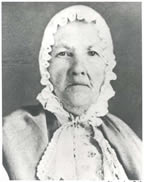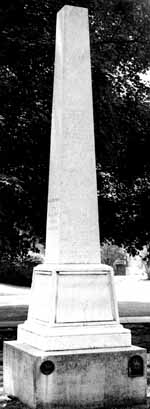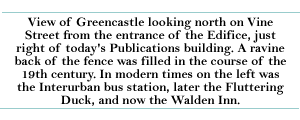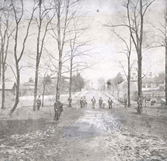|

Pages:
<< Back 1
2 3 4
5 6 7
8 9
10 Next >>
The university, having become firmly established, was now ready
for new challenges in the changing conditions of the second half
of the 19th century. Perhaps symbolic of the end of pioneer Indiana
Asbury was the erection of the Bishop Roberts gravesite monument
on the east side of the Edifice. The body
of Roberts, who presided over the Indiana Methodist Conference at
the time of the granting of the university charter, was returned
to campus along with that of his wife to reside under a stone obelisk-type
marker. This monument stands today between Harrison and Asbury halls,
the only remaining symbol of Indiana Asbury before the Civil
War.
 

___________________________________
The monument to Methodist Episcopal Bishop
and Mrs. Robert R. Roberts, which marks their gravesite, was
erected in 1859. The stone marker was a gift of the Methodist
preachers of Indiana. The only remaining object on the
DePauw campus from before the civil war.
________________________________________

_______________________
Bishop Robert R. Roberts
__________________________
The
inauguration of Thomas Bowman
as president in June 1859 was thought by many to usher in a Golden
Age for Old Asbury. The new president, who began a relationship
with the institution that was to last for 53 years, had graduated
from Dickinson College, studied law and had both business and teaching
experience. Before this able leader could preside over major changes
in the university, however, he was faced with four crisis years
of the Civil War. Despite the near-mass
exodus from campus of older boys, the university did not close,
though the law school was discontinued in 1862. In 1862-63 enrollment
slipped below 200 for the first time since 1846, with 61 in the
college and 128 in the preparatory department. Enrollment picked
up toward the end of the war, and in 1865-66 reached the highest
to date, 407, of whom 159 were in the college. It was obviously
the preparatory department, with its large number of boys below
the age of military service, which rescued the institution. The
number of faculty remained stable, although Professor Fletcher was
not replaced when he resigned.
 
Despite
the interruption of the Civil War, the
long Bowman administration-it lasted 14 years produced significant
educational progress. Alongside the traditional classical course
leading to the bachelor of arts degree and the new scientific department
which was extended to a full four-year program culminating in a
bachelor of science degree in 1858, were added a Biblical and a
normal department, making electives available for students preparing
for the ministry or for teaching.
Financial conditions improved somewhat after the war, permitting
increases in faculty salaries, which in 1867 were $1,500 per year
for professors and $2,000 for the president. While a campaign to
raise an endowment in celebration of the centenary of American Methodism
in 1866 proved disappointing, several individuals made generous
gifts to the university. The John Harmon Chair of Biblical Literature
was established in 1865 and four years later the Robert Stockwell
Professorship of Greek. Stockwell, from Lafayette, contributed an
estimated $77,000 to the university in these years. Lastly, citizens
of Greencastle contributed sufficient funds to begin to construct
a badly needed new building to supplement the facilities of the
Edifice. The cornerstone for this structure, to be located in
a large field east of the old campus, was laid on October 20, 1871.
In these years the faculty had expanded to seven positions, including
the president, who was also professor of mental and moral philosophy
as well as Harmon Professor of Biblical Literature. The veteran
Joseph Tingley remained professor of natural science throughout
the period, becoming vice-president as well in 1860. The chair of
Greek language and literature, after the resignation of Lattimore
in 1860, went to Philander Wiley. The Latin chair was held first
by Benjamin T. Hoyt and then by Lewis L. Rogers, who also served
as principal of the preparatory department for a time. In 1860 John
W Locke succeeded Cyrus Nutt in mathematics
and in 1863 German-born John A. Reubelt was appointed to teach modern
languages, followed by John E. Earp in 1869. Earp was the first
teacher with graduate training, two years at the universities of
Tubingen and Berlin. John Clark Ridpath joined the faculty in 1869
as professor of English literature and normal instruction, transferring
to the chair of Belles Lettres and history two years later.
The most important innovation of the Bowman years was the admission
of women students in 1867, 30 years after the founding of Indiana
Asbury. During those three decades the higher education of women
had been much discussed in the United States and a number of all-female
and a few coeducational colleges had been established. Greencastle
itself was the site of several "female seminaries," including
a very successful one operated by Harriet Dunn Larrabee, wife of
Professor William C. Larrabee. As early
as 1855 the Asbury trustees went so far as to appoint a committee
to consider the establishment of a "Female Department of the
University."
Back
to Top
Pages:
<< Back 1
2 3 4
5 6 7
8 9
10 Next >>
|






